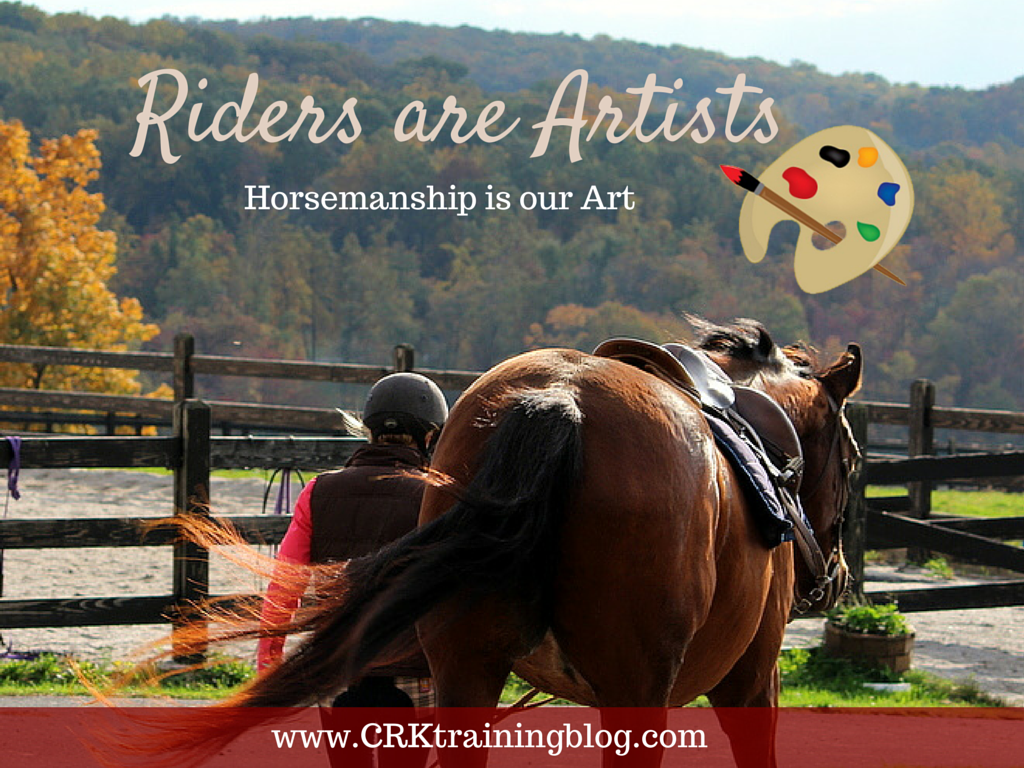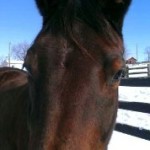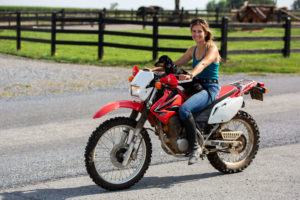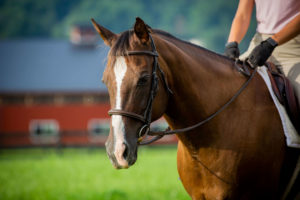Riding is an art, and those of us who pursue it with a level of focus and commitment are artists. While there is also a science to riding, training, and horsemanship, and as a more logical than intuitive thinker I am more drawn to the “science” elements of horsemanship, today I would like to discuss a few concepts I picked up while spending time with a friend of mine who is a traditional artist – a painter.
Just to clear up the definitions of art and science – when we speak of the science of horsemanship we are often referring to either learning theory or riding biomechanics or to the scientific aspects of conditioning and preparing a horse for performance. The science of horsemanship refers more to developing motor skills and learning balance and coordination – for both horse and rider.
The art of horsemanship can mean different things to different people. The art of riding may be discussed in regards to the application of learning theory and to one’s timing or to the feel and balance of riding. For some, the art of riding can also refer to other aspects of horsemanship, such as emotional control, mastering one’s energy, or even a level of spirituality.
As I mentioned, lately I’ve been spending a lot of time with a friend of mine who is an artist by profession. She paints commission pieces, mostly portraits of horses and other pets. My friend was talking about the “feel” in a painting that different artists create – there are the brush strokes on the canvas but then there is something deeper, there is that something about the painting or piece of art that captures the essence of a moment or an individual, or that brings out an emotional response from another person. This is the part of the artist’s craft that is harder to explain, and difficult to teach, but is no less real or important than the colors of the paint or angles of the lines in the picture.
Of course, there are almost endless different styles of art, artists use different mediums, like acrylic paints or water colors, and different types and colors of paper to create the look and feel of the piece they are working on.
There is really no right or wrong in art, while good artists are always looking to improve on their skills, perhaps by adding more detail to their work or improve the accuracy of lines and angles in the picture, the art is still going to be unique to the artist.
Lately I have been thinking that perhaps riding and horsemanship are not so different. Horsemanship is an art form. There are many different theories and training methods in the world today, and while it is interesting to debate the effectiveness of different exercises, theories, and methods, perhaps there is a level where there is no longer a right or wrong way to ride or train. Instead it becomes a matter of what works best for an individual horse and rider. After all, even someone who commits to a method and studies it carefully will eventually add their own style to the exercises and the theory.
Just as with any form of art, there are pieces of information and foundational skills that a novice must master, and any form of riding or training should assure the physical, mental, and emotional well-being of the horse. This is where I believe that understanding the science of horsemanship can provide the foundation or framework from where an individual can learn and expand.
In a recent interview I did with horseman Mark Rashid, I asked his opinion on science and art within horsemanship, here is part of his response and like what much of what Mark says it is concise but carries a powerful message. “What the horse needs is what you should do. If you are too caught up in the science of it, then the one thing you could do to help the horse you won’t do.”
Friendly debate and discussion is good – it keeps everyone challenging their own ideas and conclusions and therefore growing and innovating in their work.
I know we all have a tendency to get stuck in our current mode of operation, but when we can remember that what we do with our horses can become a form of art we can better appreciate and learn from the other artists we are surrounded by.
Leave a comment I would love your thoughts on this!
Callie















19 Responses
Oh yes Callie! As a musician and composer, artistry and spirituality are a huge part of my life. I also love Mark Rashid’s writings and ethos. I have only been riding for just over a year and don’t own my own horse. However, I endeavor to relate to the school horses with sensitivity, patience and calmness. Much to my surprise, they do respond even though I only spend two full days a week at the yard. I work there as a volunteer doing all the yard chores (love it!). I speak to all the horses and touch them every time I pass a stall, fill a water bucket, groom, tack up etc and they soon come to recognise me. They fill my life with love, beauty and grace and are a constant source of learning and inspiration.
I loved it–it was heartfelt and full of art.
Thanks Devony! You have helped inspire much of my pondering and new thoughts lately
Absolutely Callie!! I think riding and horsemanship, like doctors and medicine (and most things in life) are a combination of art and science. My thoughts on this topic are that most people feel comfortable discussing the “facts” and “science” because it is the more human part or the more concrete facts, and most people can accept discussing the facts or mechanics of riding, but I think it is the “art” or spiritual component (that part of riding that we can’t put our finger on, that we must feel) that makes people uncomfortable or that they find more challenging. It is probably to some degree because we can’t find the right words to describe it ~ artistry, magic, energy, spirit…. on and on. I think it is the “art” part that separates the average rider/trainer/instructor from the outstanding one. It is that little bit that we can’t describe.
Horses to me represent the universe and life with all of its dichotomies~ strong but sensitivity, power with grace….etc. For me, there is no more special place on earth, nor more heavenly or spiritual, than a barn filled with horses. A truly magical place….we are the lucky ones who know this.
Well spoken Nancy. I think you are absolutely right that it can be difficult to find the right words to teach concepts such as “feel” or to teach how to pick up on a horse that is getting anxious or frustrated. Perhaps each person needs to find their own way to understanding these concepts and that path can often look very different from the path another person takes.
Marks comment is great: What the horse needs is what you should do.
We need to remember each horse and each rider are individuals. Each has different needs and different abilities and therefore each combo of horse and rider will interact differently. This is where I think the “art” comes in. This needs to be acknowledged more often- something I think you do often. You are not afraid to let us see on your videos how one method of training may be better than another to achieve the same outcome depending on the horse and/or the rider. In otherwords, what works in one situation may not work in another, thus requiring creative thinking to solve a problem.
I thought a lot about this blog post today, while I was making delicious biscotti for the first time ~ they are fun to bake and easier than I thought. If riders are the artists, then horses are the canvas. Therefore, we must approach each one as an individual and make adjustments in the way we work with each one. Horses, like other animals that we spend time with, have a unique soul/personality; it is up to us to figure out what works best for each one.
So well put, Nancy! I hope you don’t mind, but I quoted your comment on facebook today
Fine with me Callie….That might be the first time I have ever been quoted
This was a beautiful post, Callie. It was inspiring, and it got me thinking a little bit.
I am very into the arts. To list a few: I love drawing, singing, and music. Art is beautiful, expressive, delicate, and sacred in a sense. I love to think of riding and horsemanship as arts. Aren’t they what I just listed? The connection that can be formed between rider and horse is a very special connection. It inspires, it enlightens, and it delights. That’s why I love it so much. I’m sure many others can agree.
Hi callie.
Nancy bast hit the nail on the head..
Each horse I have are totally different therefore I must ride each one in many different ways.. one needs a lot of leg. One does not like leg at all.lol example…
But facts are each horse you ride you learn as you grow with the horse and learn from the horse and what makes that horse comfortable and trusting you to do what you have to do to achieve the safest ride ..
I understand that the science of riding is very important as well it all flows together as riding . Art.. barbering.. training ..baking….everything we do in life should .. we learn what we can…some trainers teach one way.. that’s fine for some..but I take a little bit of everything from everyone see what works and dont. … and grow from there..
but callie you have taught me the most important part of riding.. safety! !
Thank you..
keep doing what you do ..
Thanks Tammy
Callie–What an eloquent article that describes what most of us horse people FEEL, but what can be hard to describe–like telling someone why a magnificent piece of art or music is just that. Working with horses evokes that feeling in me, even as I work hard on the techniques of riding and the science and practice of learning to keep horses healthy, happy, and safe. Working on the lunge line with my horse when she breaks into a floating trot just takes my breath away! Anya said it well, too–about the connection between human and horse. It is what we strive for in riding and training–and yes, when we are aware that we are connected with our horses, it is so wondrous. Please submit your article to some major horse magazines. Your ideas and Mark Rashid’s thoughts should spark a great deal of interest out there. Keep up the terrific work you do!
Thank you Maureen!
Thanks Maureen!
A good reminder to stay in the moment!
Your thoughts are a piece of art, thank you Callie! I am painter…horses are inspiration for me…i adore them, i admire them for their beauty, strength, for their beautiful soul…this leaded me to start horseback riding lessons (eventhough i am 58 y.o) i am doing very good and have much progress since last August that i started. I am so very thankful i can spend time with them…
Raiders are artists , Yes , riding is an art…an art that deeply touches the viewer’s soul, with the warmest colorstrokes, ever…!
I do enjoy your videos, your precious instructions, i do like your so tender bond with your horses…Merci Callie!
Thank you for your beautiful written response! Glad to have you in our community
-Julia Burdy, CRK Training Community Manager
What a lovely article! You have so eloquently articulated two sides of the same coin–that is, art and science. They both serve and support one another, are intertwined. I was trained in both the arts and sciences–vertebrate zoology and illustration–and I work professionally as, on one hand, a paleontological illustrator (reconstructions of prehistoric animals) and as a creature designer for the animation/entertainment industry. At this point in my career, I couldn’t begin to separate the art from the science. There are the principles (i.e. the scientific method, anatomy, cladistics, etc. as well as color theory, composition, perspective, application of traditional and digital media, and so on), but launching from those principles, there is the transcendent discovery and imagination inherent in both science and art. There are the principles of riding and training (which would take me more than many lifetime to learn, let alone master), and then, both imbuing and transcending them, there is the joy and wonder of those times when the rider and the horse are one creature. I think this is why we ride.